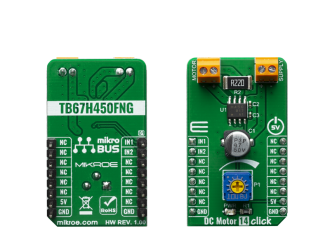
We strongly encourage users to use Package manager for sharing their code on Libstock website, because it boosts your efficiency and leaves the end user with no room for error. [more info]

Rating:
Author: MIKROE
Last Updated: 2020-01-31
Package Version: 1.0.0.0
mikroSDK Library: 1.0.0.0
Category: Brushed
Downloaded: 3966 times
Not followed.
License: MIT license
DC MOTOR 14 Click is a PWM chopper type brushed DC motor driver, labeled as TB67H450FNG. This IC includes one channel of motor output block, using a wide range of supply voltages, while delivering reasonably high current to the connected DC motors.
Do you want to subscribe in order to receive notifications regarding "DC Motor 14" changes.
Do you want to unsubscribe in order to stop receiving notifications regarding "DC Motor 14" changes.
Do you want to report abuse regarding "DC Motor 14".


Library Description
The library covers all the necessary functions to control DC Motor 14 click board. DC Motor 14 click communicates with the target board through the AN and RST lines on MikroBUS. This library offers functions for setting or clearing of both pins used for communication, also user can use functions that drive motor forward and in reverse or apply brake and stop functions.
Key functions:
void dcmotor14_forward ( ); - Function is used to drive the motor forward.void dcmotor14_reverse ( ); - Function is used to drive the motor reverse.void dcmotor14_brake ( ); - Function is used to brake the motor.Examples description
The application is composed of three sections :
void application_task ( )
{
mikrobus_logWrite( "The motor turns forward!", _LOG_LINE );
dcmotor14_forward( );
Delay_ms( 5000 );
mikrobus_logWrite( "The motor brakes!", _LOG_LINE );
dcmotor14_brake( );
Delay_ms( 2000 );
mikrobus_logWrite( "The motor turns in reverse", _LOG_LINE );
dcmotor14_reverse( );
Delay_ms( 5000 );
mikrobus_logWrite( "The motor stops", _LOG_LINE );
dcmotor14_stop( );
Delay_ms( 2000 );
}
Other mikroE Libraries used in the example:
Additional notes and informations
Depending on the development board you are using, you may need USB UART click, USB UART 2 click or RS232 click to connect to your PC, for development systems with no UART to USB interface available on the board. The terminal available in all MikroElektronika compilers, or any other terminal application of your choice, can be used to read the message.